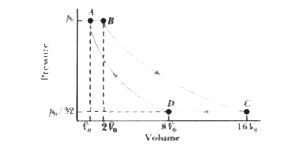PROBLEMS from RESNICK AND HALLIDAY PHYSICS (HINGLISH) THE FIRST LAW OF THERMODYNAMICS for Class 12
| Class 12 | PHYSICS |
| Chapter | THE FIRST LAW OF THERMODYNAMICS |
| RESNICK AND HALLIDAY PHYSICS (HINGLISH) | PROBLEMS |
| Medium | English |
| Academic Year | 2023-2024 |
Question 1
A lab sample of gas is taken through cyclic abca shown in the P-V diagram of fig 21-22 the net work done is + 1.5 J . Along paths Ab the change in the internal energy is +3.0 and the magnitude of the work done is 5.0 J Along path ca the energy transferred to the gas as heat is + 2.5 J . How much energy is transferred as heat along (a) path ab and (b) path bc ?
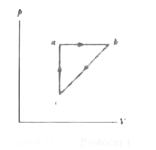 View Solution
View SolutionQuestion 3
The themodynamic system is taken from state A to state B to state C , and then back from state A to p-V diagram of fig - 21.24 a . The vertical scale is set by ps=20Pa and the table in fig . 21-24 by inserting a plus sign a minus sign or a zero in each indicated cell . (h ) what is the set work done by the system as it moves once through the cycle ABCA ?
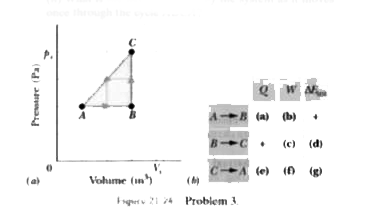 View Solution
View SolutionQuestion 7
As a gas is held within a closed chamber, it passes through the cycle shown in Fig. 21-27 Determine the energy transferred by the system as heat during constant-pressure process CA if the energy added as heat QAB during constant-volume process AB is 25.0 J, no energy is transferred as heat during adiabatic process BC and the net work done during the cycle is 15.0 J.
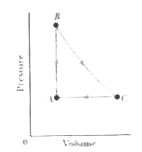 View Solution
View SolutionQuestion 8
Figure 21-28 represents a closed cycle for a gas (the figure is not drawn to scale). The change in the internal energy of the gas as it moves from a to calong the path abc is -50 J. As it moves from c to d, 45 J must be transferred to it as heat. An additional transfer of 20 J to it as heat is needed as it moves from d to a. How much work is done on the gas as it moves from c to d?
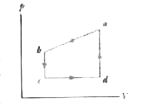 View Solution
View SolutionQuestion 9
Calculate the specific heat of a metal from the following data. A container made of the metal has a mass of 3.6 kg and contains 15 kg of water. A 1.8 kg piece of the metal initially at a temperature of 180∘C is dropped into the water. The container and water initially have a temperature of 16.0∘C, and the final temperature of the entire (insulated) system is 18.0∘C.View SolutionQuestion 11
A gas is to be expanded from initial state i to final state f along either path 1 or path 2 on a p-V diagram. Path 1 consists of three steps: an isothermal expansion (work is 23 J in magnitude), an adiabatic expansion (work is 35 J in magnitude), and another isothermal expansion (work is 16 J in magnitude). Path 2 consists of two steps: a pressure reduction at constant volume and an expansion at constant pressure . what is the change in the internal energy of gas along path 2 ?View SolutionQuestion 12
When 22.5 J was added as heat to a particular ideal gas, the volume of the gas changed from 50.0 cm3 to 100 cm3 while the pressure remained at 1.00 atm. (a) By how much did the internal energy of the gas change? If the quantity of gas present was 2.00×10−3mol, find (b)Cp and (c) CvView SolutionQuestion 13
Suppose 2.80 mol of an ideal diatomic gas, with molecular rotation but not oscillation, experienced a temperature increase of 45,0 K under constant-pressure conditions. What are (a) the energy transferred as heat , (b) the change ΔEint internal energy of the gas, (c) the work w done by the gas, and (d) the change ΔK in the total translational kinetic energy of the gas? View SolutionQuestion 14
The temperature of 4.50 mol of an ideal monatomic gas is raised 27.0 K at constant volume. What are (a) the work W done by the gas, (b) the energy transferred as heat Q. (c) the change ΔEint in the internal energy of the gas, and (d) the change ΔK in the average kinetic energy per atom? View SolutionQuestion 15
Opening champagne. In a bottle of champagne, the pocket of gas (primarily carbon dioxide) between the liquid and the cork is al pressure of pi = 4.00 atm. When the cork is pulled from the bottle, the gas undergoes an adiabatic expansion until its pressure matches the ambient air pressure of 1.00 atm. Assume that the ratio of the molar specific heats is γ= 4/3. If the gas has initial temperature T=5.00∘C, what is its temperature at the end of the adiabatic expansion? View SolutionQuestion 16
One mole of an ideal diatomic gas goes from a to c along the diagonal path in Fig. 21-29. The scale of the vertical axis is set by Pab=5.0kPaandpc=0.50kPa, and the scale of the horizontal axis is set by Va=2.0m3 During the transition, (a) what is the change in internal energy of the gas, and (b) how much energy is added to the gas as heat? (c) How much heat is required if the gas goes from a to c along the indirect path abc?
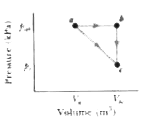 View Solution
View SolutionQuestion 17
Adiabatic wind. The normal airflow over the Rocky Mountains is west to east. The air loses much of its moisture content and is chilled as it climbs the western side of the mountains. When it descends on the eastern side, the increase in pressure toward lower altitudes causes the temperature to increase. The flow, then called a chinook wind, can rapidly raise the air temperature at the base of the mountains. Assume that the air pressure p depends on altitude y according to p=P0 exp (-ay), where P0=1.00 atm and a =1.16×10−4m. Also assume that the ratio of the molar specific heats is γ= 4/3. A parcel of air with an initial temperature of −13.0∘C descends adiabatically from Y1=4267m to y = 1567 m. What is its temperature at the end of the descent?View SolutionQuestion 19
Suppose 0.825 mol of an ideal gas undergoes an isothermal expansion as energy is added to it as heat Q. If Fig. 21-30 shows the final volume Vf versus Q, what is the gas temperature? The scale of the vertical axis is set by Vfs=0.30m3 and the scale of the horizontal axis is set by Qs=1800J.
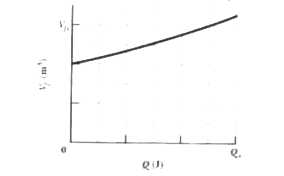 View Solution
View SolutionQuestion 20
Figure 21-31 shows a cycle undergone by 2.00 mol of an ideal monatomic gas. 2. The temperatures are T1=300K,T2=600K,andT3=455K. For 1→ 2, what are (a) heat Q, (b) the change in internal energy ΔEint, . and (c) the work done W? For 2→3. what are (d) Q. (e) ΔEint, and (f) W? For 3→1, what are (g) (h) ΔEint, and (i) W? For the full cycle, what are (j)(k) ΔEint, and (1) W? The initial pressure at point 1 is 1.00 atm (= 1.013 10% Pa). What are the (m) volume and (n) pressure at point 2 and the (o) volume and (p) pressure at point 3?
 View Solution
View SolutionQuestion 22
The volume of an ideal gas is adiabatically reduced from 350 L to 130 L. The initial pressure and temperature are 2.00 atm and 380 K. The final pressure is 8.00 atm. (a) is the gas monatomic, diatomic, or polyatomic? (b) What is the final temperature? (c) How many moles are in the gas? View SolutionQuestion 23
Under constant pressure, the temperature of 3.00 mol of an ideal monatomic gas is raised 15.0 K. What are (a) the work W done by the gas, (b) the energy transferred as heat Q. (c) the change ΔEint in the internal energy of the gas, and (d) the change ΔK in the average kinetic energy per atom? View SolutionQuestion 24
An automobile tire has a volume of 1.64×102m3 and contains air at a gauge pressure (pressure above atmospheric pressure) of 165 kPa when the temperature is 0.00°C. What is the gauge pressure of the air in the tires when its temperature rises to 37.0°C and its volume increases to 1.67×10−2m4 Assume atmospheric pressure is 1.01×105 Pa.View SolutionQuestion 28
Air that initially occupies 0.280 m at a gauge pressure of 103.0 kPa is expanded isothermally to a pressure of 101.3 kPa and then cooled at constant pressure until it reaches its initial volume. It then returns to its initial pressure in a constant-volume process. Compute the network done by the air. (Gauge pressure is the difference between the actual pressure and atmospheric pressure.) View SolutionQuestion 29
A sample of an ideal gas is taken through the cyclic process abca shown in Fig.21-33. The scale of the vertical axis is set by pb=7.5kPaandpAc=2.5kPa.At point a, T = 280 K. (a) How many moles of gas are in the sample? What are (b) the temperature of the gas at point b, (c) the temperature of the gas at point c, and (d) the Higure 21-33 Problem 30. net work done by the gas during the cycle, and (c) the net energy added to the gas as heat during the cycle?
 View Solution
View SolutionQuestion 32
Figure 21-34 shows a reversible cycle through which 1.00 mol of a monatomic ideal gas is taken. Assume that p=2p0V=2V0,P0=1.01×105 Pa, and V0=0.0335m3. Calculate (a) the work done during the cycle, (b) the energy added as heat during stroke Volume abc, and (c) the efficiency of the cycle. (d) What is the efficiency of a Carnot engine operating between the highest and lowest temperatures that occur in the cycle?
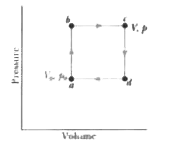 View Solution
View SolutionQuestion 34
In a hypothetical nuclear fusion reactor, the fuel is deuterium gas at a temperature of7×108 K. If this gas could be used to operate a Carnot engine with TL=50∘C, what would be the engine's efficiency? Take both temperatures to be exact and report your answer to eight significant figures. View SolutionQuestion 36
(a) During each cycle, a Carnot engine absorbs 730 J as heat from a high-temperature reservoir at 360 K, with the low-temperature reservoir at 280 K. How much work is done per cycle? (b) The engine is then made to work in reverse to function as a Carnot refrigerator between those same two reservoirs. During each cycle, how much work is required to remove 1200 J as heat from the low-temperature reservoir?View SolutionQuestion 39
A Carnot engine is set up to produce a certain work W per cycle. In each cycle, energy in the form of heat QHis transferred to the working substance of the engine from the higher-temperature thermal reservoir, which is at an adjustable temperature TH. The lower-temperature thermal reservoir is maintained at temperature TL=250K. Figure 21-37 gives QHfor a range of TH The scale of the vertical axis is set by QHs = 12.0 kJ. If TH is set at 550 K, what is QH?
 View Solution
View SolutionQuestion 40
Figure 21-38 shows a reversible cycle through which 1.00 mol of a monatomic ideal gas is taken. Volume VC = 8.00 Vb Process Adiabatic bc is an adiabatic expansion, with pb=5.00 atm and Vb=1.00×10−3m3. For the cycle, find (a) the energy added to the gas as heat, (b) the energy leaving the gas as Volume heat, (c) the network done by the gas, and (d) the efficiency of the cycle.
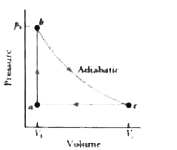 View Solution
View Solution



